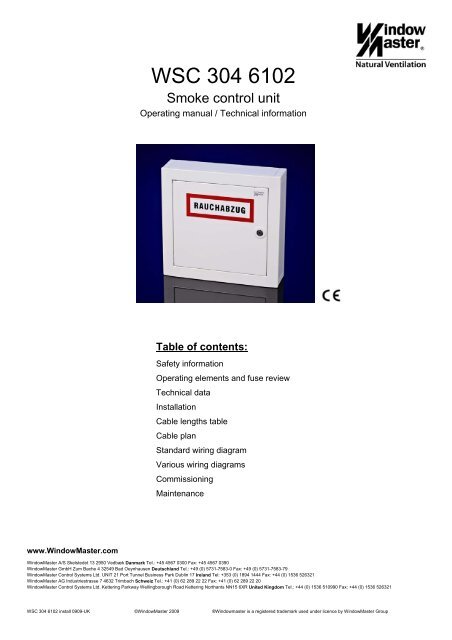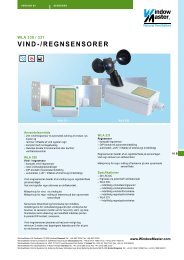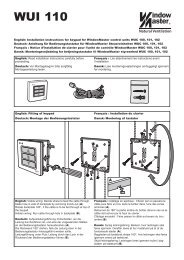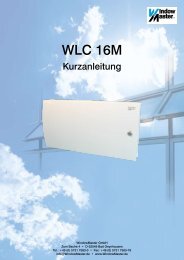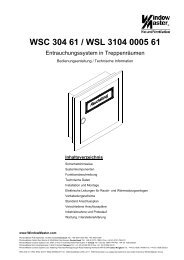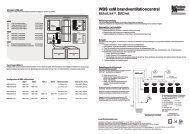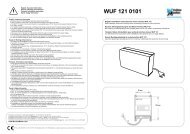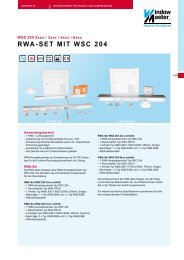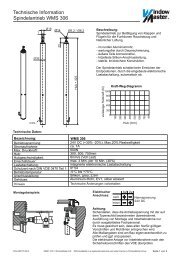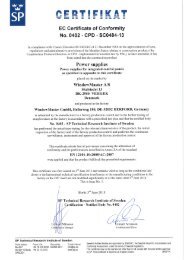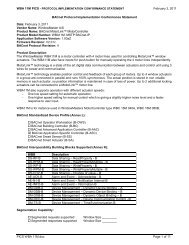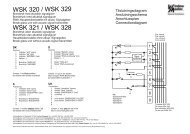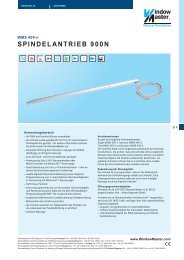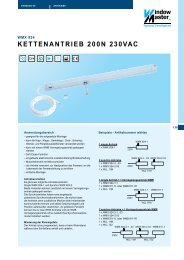WSC 304 6102 Install 0909-GB - WindowMaster
WSC 304 6102 Install 0909-GB - WindowMaster
WSC 304 6102 Install 0909-GB - WindowMaster
Create successful ePaper yourself
Turn your PDF publications into a flip-book with our unique Google optimized e-Paper software.
<strong>WSC</strong> <strong>304</strong> <strong>6102</strong><br />
Smoke control unit<br />
Operating manual / Technical information<br />
Table of contents:<br />
Safety information<br />
Operating elements and fuse review<br />
Technical data<br />
<strong>Install</strong>ation<br />
Cable lengths table<br />
Cable plan<br />
Standard wiring diagram<br />
Various wiring diagrams<br />
Commissioning<br />
Maintenance<br />
www.<strong>WindowMaster</strong>.com<br />
<strong>WindowMaster</strong> A/S Skelstedet 13 2950 Vedbæk Danmark Tel.: +45 4567 0300 Fax: +45 4567 0390<br />
<strong>WindowMaster</strong> GmbH Zum Bache 4 32549 Bad Oeynhausen Deutschland Tel.: +49 (0) 5731-7583-0 Fax: +49 (0) 5731-7583-79<br />
<strong>WindowMaster</strong> Control Systems Ltd. UNIT 21 Port Tunnel Business Park Dublin 17 Ireland Tel: +353 (0) 1894 1444 Fax: +44 (0) 1536 526321<br />
<strong>WindowMaster</strong> AG Industriestrasse 7 4632 Trimbach Schweiz Tel.: +41 (0) 62 289 22 22 Fax: +41 (0) 62 289 22 20<br />
<strong>WindowMaster</strong> Control Systems Ltd. Kettering Parkway Wellingborough Road Kettering Northants NN15 6XR United Kingdom Tel.: +44 (0) 1536 510990 Fax: +44 (0) 1536 526321<br />
<strong>WSC</strong> <strong>304</strong> <strong>6102</strong> install <strong>0909</strong>-UK ©<strong>WindowMaster</strong> 2009 ®Windowmaster is a registered trademark used under licence by <strong>WindowMaster</strong> Group
Safety information<br />
__________________________________________________________________________<br />
Attention!<br />
Adherence to the following information is mandatory:<br />
Only allow correspondingly trained, qualified<br />
and skilled personnel to carry out installation work.<br />
Reliable operation and the avoidance of<br />
damage and hazards is only guaranteed if<br />
installation and settings are carried out carefully<br />
in accordance with these instructions.<br />
Check the technical data on the system plate.<br />
Hazards to persons ensuing from flaps and<br />
wings operated by electric motors.<br />
The forces occurring in the automatic mode can<br />
be such that parts of the body could get crushed.<br />
When open ed, actuators could protrude into the<br />
room.<br />
For this reason, measures have to be taken<br />
prior to starting up the actuators which exclude<br />
the danger of injury.<br />
With wings tilting inwards or outwards, the wing<br />
must be protected from hinging down once the<br />
actuator is unhooked (e.g. for window cleaning).<br />
For safety reasons we recommend the use of<br />
catching shears.<br />
In the event that wings or flaps are subjected to<br />
high wind loads, we recommend to connect the<br />
central control unit to a wind detector which will<br />
automatically close the flaps.<br />
The fastening methods are exclusively intended<br />
for the intended use for which they are designed<br />
The manufacturer does not assume any liability<br />
for possible damage resulting from inappropriate<br />
use.<br />
230V AC dangerous voltage<br />
Can cause death, severe injury or considerable<br />
damage to assets.<br />
The connection of the control system is reserved<br />
for qualified personnel.<br />
Disconnect all poles of the unit from the supply<br />
voltage prior to opening, installation or<br />
assembling. Adhere to the national regulations.<br />
Field of application<br />
The central control system is exclusively designed<br />
for the automatic closing of smoke extraction<br />
systems, windows, flaps or doors.<br />
Always check that your system meets the valid<br />
regulations.<br />
Pay particular attention to the opening cross section,<br />
the opening time and opening speed. The cable cross<br />
sections depend on the cable length and current<br />
consumption (amperage).<br />
Maintenance work<br />
Where devices are used in smoke and heat<br />
extraction systems, ensure that they are checked,<br />
maintained and, if necessary, repaired a t least once<br />
per year.<br />
Remove all soiling from the devices,<br />
check the fastening and clamping screws for firm<br />
seating. Trial run the entire system.<br />
Defective devices may only be repaired in our factory<br />
Only use original spare parts.<br />
The supplied accumulators are subject to regular<br />
checks and must be replaced every 4 years.<br />
Cable routing and electrical connection<br />
Fuse the 230V AC power supply cable separately on<br />
site. Leave the insulation of the power supply<br />
cable in place up to the mains terminal.<br />
Adhere to the DIN and VDE regulations (Germany)<br />
or equivalent in your country.<br />
Establish the cable types, if necessary, wi th the local<br />
approval bodies or the fire protection authority.<br />
Do not conceal flexible cables. Junction box<br />
must be accessible for maintenance purposes.<br />
Disconnect all poles of the mains voltage and the<br />
accumulators prior to starting maintenance work or<br />
making changes to the system.<br />
Secure the system to prevent unintentional switching<br />
on again.<br />
Design cable types, lengths and cross sections in<br />
accordance with the technical information.<br />
Route all low voltage cables (24V DC) separate from<br />
the power current cables.<br />
Manufacturer's declaration<br />
The devices have been inspected and manufactured<br />
in accordance with the European directives.<br />
A corresponding manufacturer's declaration is<br />
available.<br />
You are only authorised to use the devices if a<br />
conformity declaration is issued for the entire system.<br />
.<br />
2
Operating elements and fuse review<br />
____________________________________________________________________________<br />
3
Technical data<br />
____________________________________________________________________________<br />
Smoke and heat extraction system alarm trip:<br />
The acoustic signal will only sounds in the break glass unit if the door is closed or if the door contact switch is<br />
pressed.<br />
Break glass unit::<br />
Break the glass in the break glass unit! Press the red button min. 0,5 sec.. The smoke extraction opens.<br />
An acoustic alarm signal sounds (continuous sound) in the break glass unit.<br />
All ventilation functions are out of operation.<br />
Display: The red alarm LED in the smoke control unit and the red LED in the break glass unit are lit.<br />
Smoke detector:<br />
If smoke develops, the smoke extraction system automatically opens.<br />
An acoustic alarm signal sounds (continuous sound) in the break glass unit.<br />
All ventilation functions are out of operation.<br />
Display: The red alarm LED in the smoke control unit, the red LED in the break glass unit, and the red LED at<br />
the tripped automatic detector are lit.<br />
Reopening the actuators<br />
The first 30 min. after a SHE-trig the actuators will be cyclically activated every 2 min in OPEN direction (to<br />
loosen frost fastened windows, domes e.g.).<br />
Resetting a tripped smoke control unit:<br />
Press the „CLOSE button“ in the break glass unit or the „Reset button” in the smoke control unit.<br />
The acoustic alarm signal in the break glass unit stops sounding.<br />
The ventilation functions are operational again once the smoke extraction system has closed.<br />
(Prior to resetting, blow out or replace the detector after it was tripped by an automatic detector).<br />
Display: The red alarm LED in the smoke control unit, the red LED in the break glass unit, and the red LED at<br />
the tripped automatic detector extinguish.<br />
Resetting a trip caused by high temperature:<br />
The smoke extraction system can be closed again by pressing the „Reset button“ in the smoke control unit or<br />
the „CLOSE button“ in the break glass unit.<br />
After operating the CLOSE function, an acoustic pulse tone sounds, and the flashing malfunction LED is only<br />
displayed in the break glass unit. The green operation LED remains lit as a special fault diagnosis.<br />
Operating the ventilation button, OPEN or STOP will lead to the tripping of another alarm.<br />
Note:<br />
The built-in thermal switch will then be irreversibly destroyed. The smoke control unit has to be returned for<br />
checking.<br />
Option: Alarm trip caused by a malfunction signal:<br />
When this function is activated (SW2/1 = ON), the smoke control unit will trip in the event of a motor, smoke<br />
detector or break glass unit circuit malfunction. An acoustic alarm signal sounds (continuous sound) in the<br />
break glass unit.<br />
If the temperature exceed 73°C the automatically SHE-alarm will be activated.<br />
An acoustic alarm signal in the smoke control unit will start.<br />
No trip occurs as a result of a malfunction in the mains or battery circuit.<br />
Display: The red alarm LED in the smoke control unit and the red LED in the break glass unit are lit.<br />
The yellow malfunction LED in the break glass unit and the corresponding yellow malfunction<br />
LED in the smoke control unit flash.<br />
Option: Accumulative signalling of the alarm or malfunction signal<br />
Module WSA 301:<br />
It is possible to send an alarm or malfunction signal potential free, by plugging in the alarm/malfunction<br />
signalling module.<br />
The sending of the alarm can be stopped. If this is done, the yellow LED on the module will lit.<br />
4
Technical data<br />
____________________________________________________________________________<br />
Cascading smoke control units:<br />
The smoke control units can be cascaded by a monitored 2 wire connection from the alarm module of the<br />
master smoke control unit to the smoke detector input of the slave central panel.<br />
A malfunction in the cascaded smoke control units is detected via the 2 wire BUS cable. The malfunction is<br />
only displayed in the corresponding smoke control unit and in the break glass unit connected to the master<br />
smoke control unit.:<br />
Ventilation functions:<br />
Ventilation OPEN:<br />
With the dead man's circuit activated (SW2/2 = ON), the actuators only move open for as long as the OPEN<br />
button of the ventilation button is kept pressed.<br />
If no dead man's function is activated (SW2/2 = OFF), the actuators open after pressing the OPEN button<br />
(self hold).<br />
Display: The ventilation open LED in the ventilation button is lit (only with LED integrated in the button).<br />
Ventilation stop:<br />
The actuators stop when both buttons are pressed.<br />
Display: The ventilation open LED in the ventilation button remains lit (only with LED integrated in the button).<br />
Ventilation closed:<br />
The actuators close after pressing the CLOSED button.<br />
Display: The ventilation open LED in the ventilation button has extinguished (only with LED integrated in the<br />
button).<br />
Option: Ventilation time module<br />
Timemodule WSA 303:<br />
Time to be set between 1 and 30 min. Once this time has elapsed, the actuators close after ventilation „OPEN“<br />
or ventilation „STOP“. This function is not operative if the setting potentiometer is on the right-hand stop.<br />
Wind/rain CLOSE:<br />
The actuators close when the wind/rain sensor has tripped (potential free contact in the sensor switches). The<br />
ventilation functions are out of operation as long as a tripped situation is pending.<br />
The tripped signal is shown with the green wind/rain LED.<br />
Alarm tripping has 1. priority.<br />
Option: Transmission of the wind/rain signal<br />
Module WSA 302:<br />
The trip signal of the wind/rain sensor can be transmitted potential free to the next smoke control unit.<br />
CLOSE after a power failure:<br />
2 minutes after a power failure actuators opened for natural ventilation will automatically.<br />
In the event of alarm, this function will be out of operation.<br />
General information:<br />
EMC protection:<br />
All inputs and outputs are protected from coupled in interferences.<br />
Short-circuit protection:<br />
All outputs are protected against short-circuit and overload.<br />
5
Technical data<br />
____________________________________________________________________________<br />
Connection possibilities:<br />
1) Actuators with a total power consumption of max. 4A<br />
2) Smoke detectors, up to 10 pieces in 1 sensor group<br />
Optical smoke detector and/or thermo-differential sensor<br />
and/or heat max. sensor WSA 300, WSA 310<br />
3) Break glass units (main), up to 4 per sensor group WSK 320 000X<br />
4) Break glass units (secondary), up to 15 WSK 330 000X<br />
5) Ventilation buttons with ‘indicator, up to 15,<br />
any number without ‘open’ indicator WSK 100 1161<br />
6) Wind/rain detector with potential free close contact WLA 330 01, WLA 331 01<br />
7) SHE activation on potential free<br />
ASV contact in the smoke sensor entrance<br />
WSA 306 install<br />
Operation / LED diagnose<br />
Pushing the reset button on the circuit board the SHE activation is reset and the actuators closes.<br />
Setting possibilities via slide switch SW1<br />
SW 1/1 = ON Inspection indication activated<br />
SW 1/1 = OFF Inspection indication not activated. After activation only a coded deactivation is possible<br />
To show the activation the LED will flash 10 sec. If this time SW1/1 is once again set on OFF, the prioritised<br />
activation is cancelled.<br />
After a period of 12 month the inspection indication will be activated: the yellow fault LED in the main break<br />
glass unit will flash and the audible fault alarm will sound. The green operating LED will still flash to show that<br />
there is no fault. An alarm signal has first priority.<br />
SW 1/2 = ON<br />
SW 1/2 = OFF<br />
Forwarding the alarm signal (WSA 301). After 3 min. it will stop.<br />
Forwarding the alarm signal (WSA 301) as long as the alarm is trigged.<br />
Setting possibilities via slide switch SW2<br />
SW 2/1 = ON<br />
Notice<br />
SW 2/1 = OFF<br />
SW 2/2 = ON<br />
SW 2/2 = OF<br />
The SHE alarm trips when malfunction signal from actuator, smoke sensor, break glass<br />
unit, max. temperature sensor. This setting is NOT approved accordingly to VdS<br />
No SHE alarm tripped when malfunction signal. Malfunction only shown on the LEDs.<br />
The actuators only open for as long as the ventilation button is pressed (dead man control)<br />
The actuators opens all up when the ventilation buttons is pressed (self hold)<br />
Diagnosis / monitoring in the control unit and fault elimination<br />
LED on the<br />
circuit board<br />
Function is OK Malfunction Diagnose<br />
Mains (green) Lit Off Check mains voltage and mains fuse<br />
Operation (green) Lit Off Check all functions<br />
Battery/load control<br />
(yellow)<br />
Off<br />
Check main fuse and charging<br />
voltage.<br />
Flashes when main failure<br />
or when charging voltage<br />
is under 26V.<br />
Lits when<br />
battery no connection,<br />
battery fuse defect,<br />
Battery voltage under 19V<br />
Check battery connection.<br />
Check battery fuse.<br />
Check battery voltage<br />
Motor circuit (yellow) Off Flashes when interrupted Check actuator fuse and<br />
actuator end module<br />
Break glass unit (yellow) Off Flashes when interrupted. Check wiring and jumper J1 in the last<br />
Lits when short circuit. or only break glass unit.<br />
Smoke detector (yellow) Off Flashes when interrupted. Check wiring and the active end<br />
Lits when short circuit module.<br />
Battery and actuator circuit malfunction be about 8 sec. delayed.<br />
6
Technical data<br />
____________________________________________________________________________<br />
Operation / LED diagnose<br />
Alarm (red) Lits when trigged<br />
Wind / rain (green) Lits when trigged<br />
Battery charge<br />
Charging voltage: 26,5V to 29V. depending on the surrounding temperature.<br />
Charging current: 350mA, current restricted.<br />
Short-circuit monitoring of the connection cables.<br />
Charging voltage disconnected in the event of a short-circuit.<br />
Note<br />
Replace the emergency power batteries every 4 years!<br />
Optional plug-in modules<br />
Multi malfunction warning module (WSA 301):<br />
Multi malfunction warning:<br />
1 x change-over contact (max. load: 60V, 1A) with 3 pole connection terminal for potential free transmission<br />
to the BMS / panel etc.<br />
2 pole connection terminal for 2 wire BUS cable for the feedback of malfunctions in cascaded control units to<br />
the break glass unit connected to the master smoke control unit.<br />
Alarm message:<br />
1 x change-over contact (max. load: 60V, 1A) with 3 pole connection terminal for potential free transmission<br />
to BMS / panel etc., or as monitored 2 wire alarm cable for cascading control centres.<br />
Jumper plugged in J1 = Only for the alarm transmission to the next smoke control unit (cascading).<br />
Jumper plugged in J2 = pot.-free alarm contact (factory setting).<br />
The transmitting can be interrupt. If so, it will be shown by the yellow LED.<br />
Wind/rain relaying module (WSA 302):<br />
1 x change-over contact (max. load: 60V, 1A) with 3 pole connection terminal for potential free transmission<br />
of the wind/rain trip.<br />
Ventilation time module (WSA 303):<br />
Automatic closing in the ventilation mode according to pre selected time (1 min. to 30 min.) after ventilation<br />
OPEN or STOP was actuated.<br />
7
Technical data<br />
____________________________________________________________________________<br />
Supply voltage 230V AC / 50Hz (+10% / -15%)<br />
Safety transformer According EN 61558<br />
Mains amperage<br />
Max. 100VA<br />
Motor output voltage<br />
Load at actuator output<br />
0A 4A<br />
Main 207V 25V DC 18V DC<br />
supply 230V 28V DC 21V DC<br />
voltage 253V 31V DC 24V DC<br />
Emergency power supply batteries<br />
Charging unit: Charging voltage 26,5V to 29V<br />
………………………… ….. Charging current<br />
Operating duration (emergency power supply )<br />
Current load of the actuators<br />
Current load of the smoke unit<br />
(batteries, surweillence, periphery)<br />
Switch-on duration<br />
2x 12V / 1,9Ah. Lifetime 4 years.<br />
350mA, current limited<br />
72 hours if batteries are fully charged (1,9Ah)<br />
Max. 4A<br />
Max. 0,7A<br />
40% ED<br />
Reopening the actuators<br />
During the first 30 min. after a SHE-trig the actuators<br />
cyclically every 2 min.<br />
Review of fuses<br />
Mains 630mA slow-blow<br />
Motor 4 A slow-blow<br />
Battery 630mA medium slow-blow<br />
Type of connection to external Mains screw terminal / plug-screw terminals / 0.5-<br />
2.5qmm<br />
Cable monitoring<br />
Automatic detectors (detector circuit with active end<br />
module), break glass unit (detector circuit with end<br />
resistor), actuators (with motor end module), batteries<br />
(cyclic measurement)<br />
Message Alarm trip / malfunction<br />
Optically alternating or steady signals by LED's.<br />
Operating and alarm tripping = steady signal.<br />
Malfunction of battery, actuator, break glass unit and<br />
smoke detector in the event of an interruption =<br />
alternating, in the event of a short circuit = steady<br />
signal<br />
Temperature<br />
-5°C - 40°C.<br />
Max. 90% relative humidity (not condensing)<br />
Protection type IP 30<br />
Housing<br />
Plastic house type UK 511 with metal door.<br />
Build in or surface mounted (with plastic frame).<br />
Protection class II.<br />
Dimensions (WxHxD) 335x350x95mm.<br />
Cut-out dimension hole (WxDxH) 335 x 350 x 95mm.<br />
Upgradeable with 1,9Ah to 2,2Ah batteries.<br />
8
<strong>Install</strong>ation<br />
____________________________________________________________________________<br />
Cable routing<br />
Observe the safety information on page 2.<br />
For cable routing we recommend the use of fire protected cables retaining their function E90 or E30.<br />
However, this has to be agreed with the Engineer or, if necessary, with the local fire protection department.<br />
Do not reduce the cable cross sections specified in the cable lengths table.<br />
All cables of the control centre (except the mains supply cable) carry 24V DC and have to be routed separate<br />
from the mains supply cable.<br />
Adhere to the pertinent national and local regulations when routing the cables.<br />
Do not use the green/yellow conductor.<br />
Ensure that the mains cable can be switched via an external or customer-supplied two-pole switch element or<br />
a switch element controlling all poles.<br />
Smoke unit installation<br />
Note that the control centre has to be installed in a dry room.<br />
Concealed housing<br />
Refer to the sketch below for the installation position<br />
Open central control and remove the housing<br />
top section (door) from the housing bottom section.<br />
Fasten the housing bottom section in the wall cut-out<br />
(cut-out dimension 335 x 350 x 95) and<br />
refit the housing top section.<br />
Also possibility for surface mounting with the included frame.<br />
<strong>Install</strong>ation of the Break glass unit, ventilation buttons and detectors<br />
Ensure that the Break glass unit and the ventilation buttons are visible and well accessible.<br />
Do not install behind protruding walls, door panels or hidden by the building structure.<br />
Note: <strong>Install</strong>ation height of the Break glass unit = 1.4 m above floor.<br />
<strong>Install</strong> the automatic detectors in accordance with their enclosed instructions.<br />
<strong>Install</strong>ation<br />
Lead the connection cables into the housing of the control centre from above.<br />
All connection terminals (except the mains terminals) are of the plug-in type.<br />
Connect the connection cables in accordance with the terminal plan. Ensure that the connections are made<br />
correctly.<br />
Incorrect clamping, mixing up numbers or colours could lead to malfunctions of the central control or of the<br />
external components.<br />
Ensure that the electrical cables are always routed according to the valid national and local regulations of the<br />
individual country.<br />
9
Cable lengths table<br />
____________________________________________________________________________<br />
Maintaining the cable functions<br />
According to valid national regulations.<br />
The cable network for smoke ventilation systems („Cable system“) ends at the interface (junction box) for the<br />
actuator!<br />
The flexible, heat resistant connection cable of the smoke ventilation system actuator is part of the system<br />
component ‚electric motor actuation' and does not belong to the electrical installation!<br />
We recommend in all cases to discuss the type of cable routing with the competent fire fighting<br />
authorities.<br />
Cable length table<br />
For determining the maximum permissible cable lengths between the smoke control unit and the actuators,<br />
taking into account the specified cables cross sections, please refer to the following table:<br />
Maximum motor current: 4A (Note: Be aware of the overall capacity of the smoke control unit!)<br />
Maximum cable length: (always routed from the central smoke control unit to the last junction box)<br />
Actuating current: Sum of all motor currents per group module<br />
Note:<br />
Do not use the green/yellow wire!<br />
Per motor supply line, 3 wires are required ( 2 wires current carrying /1 wire for monitoring )<br />
Cross section 3 wire 5 wire 3 wire 5 wire 3 wire<br />
1,5 mm² 1,5 mm² 2,5 mm² 2,5 mm² 4 mm²<br />
Actuator current<br />
in Amps<br />
(2 wires in<br />
parallel)<br />
(2 wires in<br />
parallel)<br />
1 84,00 m 168,00 m 140,00 m 280,00 m 224,00 m<br />
2 42,00 m 84,00 m 70,00 m 140,00 m 112,00 m<br />
3 28,00 m 56,00 m 46,67 m 93,33 m 74,67 m<br />
4 21,00 m 42,00 m 35,00 m 70,00 m 56,00 m<br />
(The information is valid for ambient temperatures of 25°C)<br />
Formula for the calculation of the maximum cable length<br />
Permissible max. voltage drop in the line UL : 2 Volt<br />
max. cable length = permissible voltage drop(UL) x conductivity of copper(56) x cable cross section(A)<br />
max. actuator current total (I) in amps x 2<br />
Permissible cable length for the break glass unit supply cable when using......4x2x0.8mm:<br />
up to 200m<br />
The motor connection cable length to the junction box (or control module) must not exceed 10 m.<br />
10
Cable plan<br />
____________________________________________________________________________<br />
11
Standard wiring diagram<br />
__________________________________________________________________________<br />
WSA 300<br />
<strong>WSC</strong> <strong>304</strong> <strong>6102</strong><br />
WSK 320 / WSK 330<br />
First or secundary<br />
Break glass unit<br />
If only one break glass unit – usa a<br />
main break glass unit.<br />
First or secundary<br />
Break glass unit<br />
WLA 330 / WLA331<br />
12
Various wiring diagrams<br />
____________________________________________________________________________<br />
13
Commisioning<br />
____________________________________________________________________________<br />
When error message occur, please refer to chapter Operating elements and fuse review.<br />
An acoustic message only occurs in the Break glass unit with the door closed or the door contact switch<br />
pressed!<br />
1)<br />
The control centre is completely installed, without the operating voltage applied<br />
a) Check all mechanical and electrical components for damage.<br />
b) Check the DIP slide switches in the control centre for their correct (required) position.<br />
c) Check all screw and plug connections for tightness and/or firm seating.<br />
d) Check that all external components are installed.<br />
Actuators:<br />
Is the final module at the last or only actuator inserted<br />
Automatic detectors: Is the active end module at the last or only detector inserted<br />
Manual detectors: Is the jumper only inserted in the last or only operating panel<br />
2)<br />
With mains voltage, without accumulator<br />
Adhere to the relevant regulations! Externally disconnect the mains voltage.<br />
a) Connect the mains cables and reapply the mains voltage.<br />
b) The mains LED is ON, the operating LED is OFF, the accumulator LED is ON. The malfunction message at<br />
the operating panels is ON.<br />
3)<br />
4)<br />
5)<br />
6)<br />
With mains voltage, with accumulator<br />
a) Remove the protection film of the lateral adhesive tape for the 1.9 Ah battery, and firmly press the two<br />
batteries together according to the picture (next page).<br />
b) Remove the protection film from one face of the supplied foam rubber. Glue each foam rubber to the<br />
bottom side of the accumulators. Connect the accumulators to the black accumulator bridge according to<br />
the wiring diagram, then connect the red and the blue connection cable to the red and the black flat plug.<br />
Remove the bottom protection film of the foam rubber and insert the batteries in the control unit according<br />
to figure 1, and firmly press down to the housing bottom!<br />
c) Plug the red connection cable to the + and the blue connection to the flat plug of the control unit. Note:<br />
Check correct polarity!<br />
d) The operating LED is ON, the accumulator LED is OFF. The malfunction message at the operating panels<br />
is OFF.<br />
Ventilation button<br />
a) Closely observe the actuators during opening and closing. They must not be impaired in any<br />
position by the building structure. Also the motor connection cables<br />
must not be subject to pulling or crushing.<br />
b) Briefly actuate the Open button to have the actuators move open up to the final position. With the SW2/2<br />
=ON (hold-to-run) setting, the actuators only move as long as the button is pressed. The OPEN display (if<br />
existing) in the button is ON.<br />
c) Briefly actuate the CLOSED button, the actuators close. The Open display is OFF.<br />
d) Press both buttons simultaneously while running, this corresponds to stop. The ventilation Open display is<br />
ON, the actuators stop.<br />
e) Briefly press the Closed button again, the actuators fully close, the Open display is OFF.<br />
Break glass unit<br />
a) Open the door and press the red Open button. The actuators move open through to the end position. The<br />
red alarm LED (also in the control unit) is ON, at the same time a permanent acoustic signal sounds (door<br />
contact pressed!).<br />
b) While running, press the Closed button at the ventilation button, then press both buttons, the actuators<br />
must neither close nor stop!<br />
c) Press the reset/Closed button in the break glass unit. The actuators close through to the end position. The<br />
ventilation function is released again. The red alarm LED (also in the control unit) and the signal generator<br />
are OFF.<br />
Break glass unit (secondary)<br />
a) Check as described under 5). „Operation“, „Malfunction“ and the acoustic signal are missing!<br />
14
Commisioning<br />
____________________________________________________________________________<br />
7)<br />
8)<br />
9)<br />
Automatic detectors<br />
a) Spray test aerosol on the detectors.<br />
b) The actuators move open through to the end position. The red LED in the detector, the red alarm LED (also<br />
in the control unit) and the permanent acoustic signal in the operating panel are ON.<br />
c) While running, press the Closed button at the ventilation button, then press both buttons, the actuators<br />
must neither close nor stop!<br />
d) Press the reset/Closed button in the operating panel. The actuators close through to the end position. The<br />
ventilation function is released again. The red alarm LED (also in the control unit) and the signal generator<br />
are OFF.<br />
Emergency power supply test<br />
a) Remove the mains fuse from the control centre. Adhere to the relevant regulations!<br />
b) The green mains and operating LED's are OFF, the yellow accumulator Led is flashing (control unit in the<br />
accumulator mode).<br />
The malfunction message at the break glass unit is ON.<br />
c) The ventilation buttons are deactivated.<br />
d) If the actuators were open, they will automatically close after 2 minutes.<br />
e) Test the SHE trip and reset/closed as described under 5).<br />
f) Refit the mains fuse.<br />
g) The green mains and operating LED's are ON, the yellow accumulator LED is OFF. The malfunction<br />
message at the break glass units is OFF.<br />
Aktivation of internal check<br />
a) Disconnect the smoke vent unit from the mains and back-up batteries<br />
b) Exchange the blind jumper J2 for active jumper J1<br />
c) Reconnect the smoke vent unit to the mains and back-up batteries<br />
d) The operation LED flashes app. 10 seconds to control the activation<br />
10) Wind/rain detector<br />
a) Open the actuators with the ventilation button.<br />
b) Wet the rain sensor, the actuators will fully close, the green wind/rain LED in the control centre is ON.<br />
c) While running, press the Open button at the ventilation button, then press both buttons, the actuators must<br />
neither open nor stop!<br />
d) The Smoke trip has priority.<br />
When the start-up was successful, then close the doors of the break glass units and of the control unit.<br />
If the start-up was unsuccessful (error with one of the test run processes), please refer to the chapter Function<br />
description and Operating elements and fuse review. If necessary, check the wiring in accordance with the<br />
wiring diagram.<br />
15
Maintenance<br />
____________________________________________________________________________<br />
The units of the smoke detection and heat extraction system have to be checked, serviced and, if necessary,<br />
repaired at least once per year by the manufacturer or an authorised specialist company.<br />
We also recommend the above to be carried out for pure ventilation units.<br />
Remove all soiling from the units of the smoke ventilation system. Check fastening and clamping screws for firm<br />
seating.<br />
Carry out a test run of the entire system (see chapters Start-up and Test Run).<br />
Only have defective units repaired in our factory. Only install original spare parts.<br />
Check the operational condition at regular intervals.<br />
We recommend to sign a maintenance contract with the manufacturer or an authorised specialist company.<br />
All batteries coming with the smoke control unit as standard, have to be subjected to regular checks.<br />
Within the framework of the service, they have to be replaced after the specified 4 year operating period.<br />
Adhere to the laws governing the disposal of hazardous substances (e.g. batteries).<br />
16


